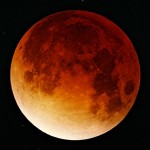
Sky watchers will be in for a rare treat the evening of Sunday, Sept. 27. If you go outside at 9:15 p.m., you’ll be able to experience the last total lunar eclipse visible from Gainesville until 2019.
“This particular total lunar eclipse is the last in a series of four sequential total lunar eclipses,” said James Albury, planetarium coordinator for the Kika Silva Pla Planetarium at Santa Fe College. “This rare pattern of eclipses is called a tetrad. The next tetrad won’t occur until 2032 and after this series of eclipses is over, there won’t be another total lunar eclipse until 2018, and we won’t be able to see one in Gainesville until 2019. We’re in a unique position in Gainesville, because we were able to experience all four of these total lunar eclipses. This eclipse will be in the early evening on a Sunday night, so the timing is almost perfect. The first three eclipses were in the early morning before sunrise on April 15, 2014, October 8, 2014 and April 4, 2015. So, if they missed the first three eclipses, we’re encouraging people to experience this last one.”
The Kika Silva Pla Planetarium at Santa Fe College, in collaboration with the Alachua Astronomy Club, is celebrating this event with a special showing of the presentation “Eclipse: The story of our nearest neighbor in space,” and free telescope viewings during the eclipse itself (weather permitting).
“Eclipse [the planetarium show] takes audiences on a journey of discovery to our nearest celestial neighbor, the moon,” Albury said. “This show specifically focuses on the moon and we’ll discuss the origin, composition and mechanics of the moon. We also review how the ancients were able to predict eclipses so accurately, and we give you all the details about this upcoming eclipse.”
Show times for “Eclipse: The story of our nearest neighbor in space,” will be as follows:
- Saturday, Sept. 26 at 7 p.m.
- Sunday, Sept. 27 at 8 p.m.
Admission is $5 for adults, and $4 for children (ages 4-12 years old), senior citizens (Ages 60+) and UF Gator-1 ID holders. Admission is free for anyone 3 years old or younger, and anyone with a valid Santa Fe College ID also receives free admission. The doors to the planetarium open 30 minutes prior to show time and the planetarium seats 60 people. Due to a high expected turnout for the Sunday evening performance, visitors are encouraged to purchase their tickets online in advance.
The telescopic viewing is free and open to the public.
“Totality for the eclipse—when the moon turns red—will happen near 10:15 p.m. Although a telescope isn’t required to experience the eclipse, sometimes it’s fun to enjoy the eclipse with a group of people,” added Albury. “We will have members of the Alachua Astronomy Club with their telescopes set up for viewing, as well as up to 100 or more of Santa Fe College’s astronomy students viewing the eclipse with us. It should be quite an experience.”
For more information about the Sept. 27 total lunar eclipse or the planetarium in general, please contact James Albury at james.albury@sfcollege.edu or 352-395-5381. You can also visit the planetarium’s website at http://www.sfcollege.edu/planetarium for more information and to purchase tickets online.
